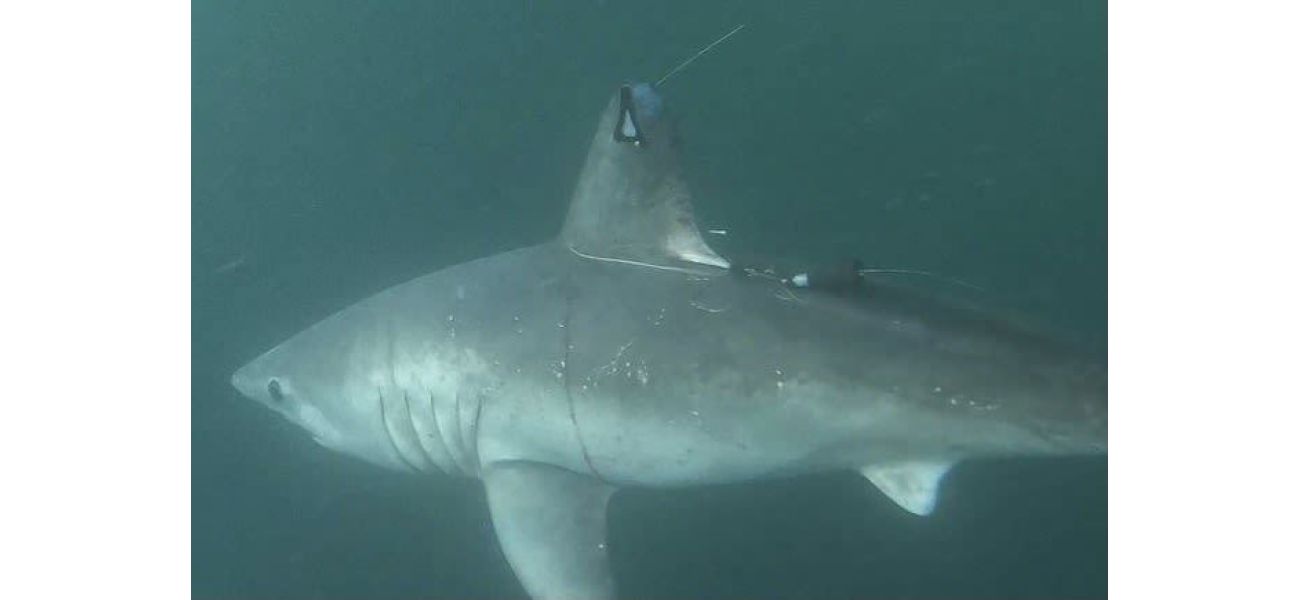Solving a shark murder mystery can be challenging and requires careful investigation.
Scientists tagged a pregnant porbeagle shark in Oct. 2020, but were surprised when their tracker recorded sharks hunting each other.
September 8th 2024.

In October of last year, a team of scientists embarked on a mission to study the habitat of the porbeagle shark by attaching a tracking device to a pregnant female. Little did they know, this would lead to a groundbreaking discovery about the predatory behavior of these creatures. In March of this year, the tracker picked up some unusual activity, revealing that the shark had been eaten by a larger predator. This unexpected finding was shared in a new study published in the journal Frontiers in Marine Science on Tuesday.
Lead study author, Dr. Brooke Anderson, a marine fisheries biologist from the North Carolina Department of Environmental Quality, expressed her surprise at this discovery in an email. She stated that this was the first recorded case of a porbeagle shark being preyed upon anywhere in the world. These elusive creatures, found in the Atlantic and South Pacific oceans as well as the Mediterranean Sea, can reach lengths of over 12 feet and weigh up to 507 pounds. They have a lifespan of 30-65 years, but females cannot reproduce until they are 13 years old, giving birth to four pups every one or two years.
Sadly, porbeagle sharks are facing many threats, including habitat loss, overfishing, and becoming caught as bycatch in fishing nets. In fact, the Northwest Atlantic porbeagle sharks are listed as vulnerable on the International Union for Conservation of Nature Red List of Threatened Species. Anderson pointed out the devastating impact of this predation event, stating that not only did the population lose a reproductive female, but also all of her developing babies. This could have major consequences for a population that is already struggling due to overfishing.
The researchers have now identified two possible suspects in this scientific murder mystery - a great white shark and a shortfin mako shark. This discovery has changed the way scientists think about the interactions between large sharks. The original purpose of the tagging mission was to track the movements of pregnant porbeagle sharks in order to identify areas that require conservation and protection efforts. Anderson and her team have been studying these creatures for over a decade and have become experts at tagging them for study.
The process of tagging the sharks involves using rods and reels to catch them and bring them aboard the boat. The sharks are then fitted with saltwater pumps in their mouths to allow them to breathe and calm down. Anderson stated that they have tagged dozens of porbeagle sharks in the past 10 years and are currently analyzing the data to determine the most important habitats for conservation and management efforts. Each shark is equipped with two satellite tags - one mounted on the fin and one that pops off after a certain amount of time, floats to the surface, and transmits its data to satellites.
The fact that the pregnant porbeagle was preyed upon by a larger shark turned out to be an unexpected bonus discovery for the team. After being tagged and released, the shark, measuring 2.2 meters long, spent five months mostly underwater, diving to depths of 100-200 meters at night and 600-800 meters during the day. The ocean temperature ranged from 6.4 to 23.5 degrees Celsius. After 158 days, the pop-off tag began to transmit data from the sea southwest of Bermuda, indicating that it had come off the shark and was floating on the ocean's surface.
For four days in March of this year, the tag recorded a constant temperature of 22 degrees Celsius at depths ranging from 150 to 600 meters before finally floating up to the surface. After analyzing the data, the team was able to determine that the shark had been eaten by a larger predator, and the tag had been excreted. Anderson explained that the sudden spike in temperature recorded by the tag, even at a depth of 600 meters, indicated that it was now inside the stomach of a warm-bodied predator, such as a lamnid shark. In addition, there was a slight change in the diving pattern recorded by the tag, further supporting the idea that it was now tracking another animal. This discovery has shed light on the complex and often surprising interactions between large sharks in the ocean.
In October of 2020, a team of scientists decided to attach a tracking device to a pregnant porbeagle shark in order to learn more about its habitat. Little did they know, their tracker would end up gathering evidence of a shocking and rare occurrence: the predation of a large shark by an even larger one.
It wasn't until March of 2021 that the tracker registered some unusual activity, leading the scientists to realize that their research subject had been consumed by a bigger shark. This unexpected finding was recently published in a study in the journal Frontiers in Marine Science, with lead author Dr. Brooke Anderson, a marine fisheries biologist, sharing the news via email.
According to Dr. Anderson, this is the first documented instance of a porbeagle shark being preyed upon anywhere in the world. These elusive creatures can reach over 12 feet in length and weigh up to 507 pounds. They have a lifespan of 30 to 65 years, but female porbeagles are unable to reproduce until they are 13 years old. When they do give birth, they have four pups every one or two years.
Unfortunately, porbeagle shark populations are facing threats such as habitat loss, overfishing, and becoming caught as bycatch in fishing nets. In fact, Northwest Atlantic porbeagle sharks are listed as vulnerable on the International Union for Conservation of Nature Red List of Threatened Species. Dr. Anderson explains that this predation event not only resulted in the loss of a reproductive female, but also all of her developing babies. This could have major implications for a population that is already struggling due to overfishing.
The researchers have identified two suspects in this scientific murder mystery: a great white shark and a shortfin mako shark. This discovery may change the way scientists think about the interactions between large sharks.
The initial purpose of attaching tracking devices to the porbeagle sharks was to identify areas where pregnant sharks and their newborn pups require conservation and protection efforts. Dr. Anderson and her team have been studying these sharks for over a decade, and they have become experts at tagging them for study.
To tag the sharks, the researchers use rods and reels to catch them and bring them on board their boat. They also place saltwater pumps in the sharks' mouths to help them breathe. According to Dr. Anderson, the sharks actually become quite calm during this process, making it easier to tag them. In the past 10 years, they have tagged dozens of porbeagle sharks and are currently analyzing the data to determine the most important habitats for the population.
Each shark is outfitted with two satellite tags: one mounted on their fin and one that pops off after a certain amount of time and transmits data to satellites. The fin-mount tags transmit the shark's location when its fins are above the ocean's surface, while the pop-off tags measure depth and ocean temperatures.
The fact that the pregnant porbeagle shark was prey for a larger shark turned out to be a bonus scientific discovery. The shark, measuring 2.2 meters long, stayed underwater for five months, swimming at depths of 100 to 200 meters at night and 600 to 800 meters during the day. The ocean temperature ranged from 6.4 to 23.5 degrees Celsius.
After 158 days, the pop-off tag began transmitting data from the sea southwest of Bermuda, indicating that it had come off the shark and was floating on the ocean's surface. For four days in March of 2021, the tag recorded a constant temperature of 22 degrees Celsius at a depth of 150 to 600 meters before it floated to the surface.
Dr. Anderson and her team were able to piece together several factors that suggested the shark had been eaten and the tag excreted by a larger predator. The sudden spike in temperature recorded by the tag, even at a depth of 600 meters, was a key indicator that the tag was inside the stomach of a warm-bodied predator, such as a lamnid shark. Additionally, there was a slight change in the diving pattern recorded by the tag, further confirming that it was now tracking a different animal. These findings shed new light on the behavior and interactions of large sharks and highlight the importance of conservation efforts for vulnerable species like the porbeagle shark.
Lead study author, Dr. Brooke Anderson, a marine fisheries biologist from the North Carolina Department of Environmental Quality, expressed her surprise at this discovery in an email. She stated that this was the first recorded case of a porbeagle shark being preyed upon anywhere in the world. These elusive creatures, found in the Atlantic and South Pacific oceans as well as the Mediterranean Sea, can reach lengths of over 12 feet and weigh up to 507 pounds. They have a lifespan of 30-65 years, but females cannot reproduce until they are 13 years old, giving birth to four pups every one or two years.
Sadly, porbeagle sharks are facing many threats, including habitat loss, overfishing, and becoming caught as bycatch in fishing nets. In fact, the Northwest Atlantic porbeagle sharks are listed as vulnerable on the International Union for Conservation of Nature Red List of Threatened Species. Anderson pointed out the devastating impact of this predation event, stating that not only did the population lose a reproductive female, but also all of her developing babies. This could have major consequences for a population that is already struggling due to overfishing.
The researchers have now identified two possible suspects in this scientific murder mystery - a great white shark and a shortfin mako shark. This discovery has changed the way scientists think about the interactions between large sharks. The original purpose of the tagging mission was to track the movements of pregnant porbeagle sharks in order to identify areas that require conservation and protection efforts. Anderson and her team have been studying these creatures for over a decade and have become experts at tagging them for study.
The process of tagging the sharks involves using rods and reels to catch them and bring them aboard the boat. The sharks are then fitted with saltwater pumps in their mouths to allow them to breathe and calm down. Anderson stated that they have tagged dozens of porbeagle sharks in the past 10 years and are currently analyzing the data to determine the most important habitats for conservation and management efforts. Each shark is equipped with two satellite tags - one mounted on the fin and one that pops off after a certain amount of time, floats to the surface, and transmits its data to satellites.
The fact that the pregnant porbeagle was preyed upon by a larger shark turned out to be an unexpected bonus discovery for the team. After being tagged and released, the shark, measuring 2.2 meters long, spent five months mostly underwater, diving to depths of 100-200 meters at night and 600-800 meters during the day. The ocean temperature ranged from 6.4 to 23.5 degrees Celsius. After 158 days, the pop-off tag began to transmit data from the sea southwest of Bermuda, indicating that it had come off the shark and was floating on the ocean's surface.
For four days in March of this year, the tag recorded a constant temperature of 22 degrees Celsius at depths ranging from 150 to 600 meters before finally floating up to the surface. After analyzing the data, the team was able to determine that the shark had been eaten by a larger predator, and the tag had been excreted. Anderson explained that the sudden spike in temperature recorded by the tag, even at a depth of 600 meters, indicated that it was now inside the stomach of a warm-bodied predator, such as a lamnid shark. In addition, there was a slight change in the diving pattern recorded by the tag, further supporting the idea that it was now tracking another animal. This discovery has shed light on the complex and often surprising interactions between large sharks in the ocean.
In October of 2020, a team of scientists decided to attach a tracking device to a pregnant porbeagle shark in order to learn more about its habitat. Little did they know, their tracker would end up gathering evidence of a shocking and rare occurrence: the predation of a large shark by an even larger one.
It wasn't until March of 2021 that the tracker registered some unusual activity, leading the scientists to realize that their research subject had been consumed by a bigger shark. This unexpected finding was recently published in a study in the journal Frontiers in Marine Science, with lead author Dr. Brooke Anderson, a marine fisheries biologist, sharing the news via email.
According to Dr. Anderson, this is the first documented instance of a porbeagle shark being preyed upon anywhere in the world. These elusive creatures can reach over 12 feet in length and weigh up to 507 pounds. They have a lifespan of 30 to 65 years, but female porbeagles are unable to reproduce until they are 13 years old. When they do give birth, they have four pups every one or two years.
Unfortunately, porbeagle shark populations are facing threats such as habitat loss, overfishing, and becoming caught as bycatch in fishing nets. In fact, Northwest Atlantic porbeagle sharks are listed as vulnerable on the International Union for Conservation of Nature Red List of Threatened Species. Dr. Anderson explains that this predation event not only resulted in the loss of a reproductive female, but also all of her developing babies. This could have major implications for a population that is already struggling due to overfishing.
The researchers have identified two suspects in this scientific murder mystery: a great white shark and a shortfin mako shark. This discovery may change the way scientists think about the interactions between large sharks.
The initial purpose of attaching tracking devices to the porbeagle sharks was to identify areas where pregnant sharks and their newborn pups require conservation and protection efforts. Dr. Anderson and her team have been studying these sharks for over a decade, and they have become experts at tagging them for study.
To tag the sharks, the researchers use rods and reels to catch them and bring them on board their boat. They also place saltwater pumps in the sharks' mouths to help them breathe. According to Dr. Anderson, the sharks actually become quite calm during this process, making it easier to tag them. In the past 10 years, they have tagged dozens of porbeagle sharks and are currently analyzing the data to determine the most important habitats for the population.
Each shark is outfitted with two satellite tags: one mounted on their fin and one that pops off after a certain amount of time and transmits data to satellites. The fin-mount tags transmit the shark's location when its fins are above the ocean's surface, while the pop-off tags measure depth and ocean temperatures.
The fact that the pregnant porbeagle shark was prey for a larger shark turned out to be a bonus scientific discovery. The shark, measuring 2.2 meters long, stayed underwater for five months, swimming at depths of 100 to 200 meters at night and 600 to 800 meters during the day. The ocean temperature ranged from 6.4 to 23.5 degrees Celsius.
After 158 days, the pop-off tag began transmitting data from the sea southwest of Bermuda, indicating that it had come off the shark and was floating on the ocean's surface. For four days in March of 2021, the tag recorded a constant temperature of 22 degrees Celsius at a depth of 150 to 600 meters before it floated to the surface.
Dr. Anderson and her team were able to piece together several factors that suggested the shark had been eaten and the tag excreted by a larger predator. The sudden spike in temperature recorded by the tag, even at a depth of 600 meters, was a key indicator that the tag was inside the stomach of a warm-bodied predator, such as a lamnid shark. Additionally, there was a slight change in the diving pattern recorded by the tag, further confirming that it was now tracking a different animal. These findings shed new light on the behavior and interactions of large sharks and highlight the importance of conservation efforts for vulnerable species like the porbeagle shark.
[This article has been trending online recently and has been generated with AI. Your feed is customized.]
[Generative AI is experimental.]
0
0
Submit Comment





